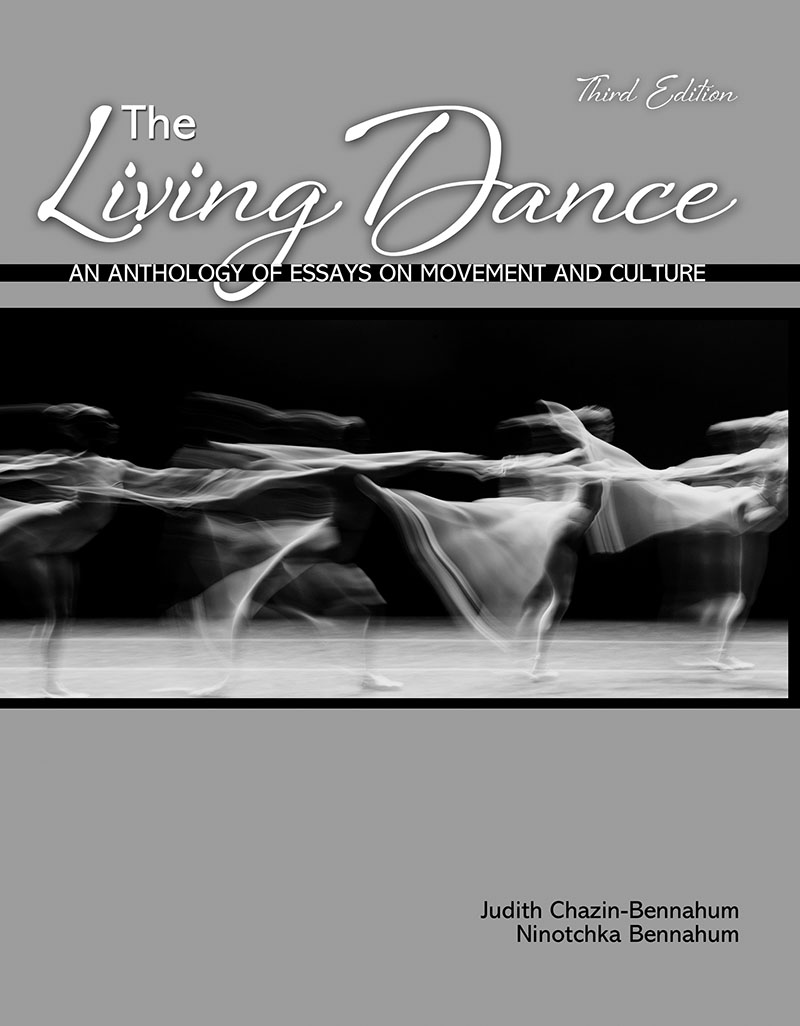The Living Dance: An Anthology of Essays on Movement and Culture
Author(s): Judith Bennahum , Ninotchka Bennahum
Edition: 3
Copyright: 2012
Pages: 332
The essays in The Living Dance: An Anthology of Essays on Movement and Culture explore the history of both eastern and western forms of dance, and emphasize important trends in contemporary theatrical and social performance. Each of the dances discussed brings into focus the vitality and richness of the cultures that produced them.
Completely updated throughout, the 3rd edition of The Living Dance examines:
- Native American Dances of New Mexico
- Mexican and New Mexican Dances
- Deep Song Dances of Gypsy Blacksmiths
- Modernism in Dance
- African American Influences on Dance
- Dance in India
- Dance in Film
- A Critical Appreciation of Dances
The Living Dance demonstrates how important the local knowledge of movement styles informs the essential understanding of how dance functions on many levels.
Throughout the book, the reader witnesses the way dance responds to conquest, fusion, the advancement of subcultures, gender roles, fashions of clothing on the body while dancing, and to the survival of communities.
Through the essays, numerous photographs, and reflection journal, the reader will learn the power of dance during their quest for mutual cross-cultural understanding.
Featuring three new authors (Dawn Lille, Michelle Hayes, and Yasmine Jahanmir), The Living Dance provides a contemporary, critical, and feminist perspective to the history of dance.
Chapter 1: Native American Dances of New Mexico
Zuni Ceremonial by Tom Bahti
Tewa Village Rituals by Jill Sweet
Chapter 2: Mexican and New Mexican Dances
A Brief Historical Introduction to Mexican and New Mexican Folk Dances by Bridgit Lujan and Marcela Sandoval
The Matachines Dance of My People by Jo Marie Griego Lubarsky
Chapter 3: Deep Song Dances of Gypsy Blacksmiths
Flamenco: Music, Movement, and Meaning by Michelle Hayes
Chapter 4: Modernism in Dance
Modern Dance – Tradition in Process by Marcia B. Siegel
Global Avante-Garde: 1995–2012 by Dawn Lille
Chapter 5: Ballet
Reinvention and Continuity Over Six Centuries by Lynn Garafola
Chapter 6: The Africanist Presence in American Dance
Social Dances of African Americans by Sally Sommer
The Home-Grown American Dance Forms—Jazz and Tap Dancing by Kathy M. Milazzao
Chapter 7: Dance in India: Where Are We Today?
Dance in India: Where Are We Today? by Ananya Chatterjea
Chapter 8: Dance in Film
Dance in Film by Beth Genné
Chapter 9: Analyzing and Writing Critically about Dance
The Critical Appreciation of Dances by Larry Lavender
Chapter 10: Intelligent Bodies: Dance’s Critical Corporeality
Intelligent Bodies: Dance’s Critical Corporeality by Yasmine Jahanmir
Reflection Journal
Index
The essays in The Living Dance: An Anthology of Essays on Movement and Culture explore the history of both eastern and western forms of dance, and emphasize important trends in contemporary theatrical and social performance. Each of the dances discussed brings into focus the vitality and richness of the cultures that produced them.
Completely updated throughout, the 3rd edition of The Living Dance examines:
- Native American Dances of New Mexico
- Mexican and New Mexican Dances
- Deep Song Dances of Gypsy Blacksmiths
- Modernism in Dance
- African American Influences on Dance
- Dance in India
- Dance in Film
- A Critical Appreciation of Dances
The Living Dance demonstrates how important the local knowledge of movement styles informs the essential understanding of how dance functions on many levels.
Throughout the book, the reader witnesses the way dance responds to conquest, fusion, the advancement of subcultures, gender roles, fashions of clothing on the body while dancing, and to the survival of communities.
Through the essays, numerous photographs, and reflection journal, the reader will learn the power of dance during their quest for mutual cross-cultural understanding.
Featuring three new authors (Dawn Lille, Michelle Hayes, and Yasmine Jahanmir), The Living Dance provides a contemporary, critical, and feminist perspective to the history of dance.
Chapter 1: Native American Dances of New Mexico
Zuni Ceremonial by Tom Bahti
Tewa Village Rituals by Jill Sweet
Chapter 2: Mexican and New Mexican Dances
A Brief Historical Introduction to Mexican and New Mexican Folk Dances by Bridgit Lujan and Marcela Sandoval
The Matachines Dance of My People by Jo Marie Griego Lubarsky
Chapter 3: Deep Song Dances of Gypsy Blacksmiths
Flamenco: Music, Movement, and Meaning by Michelle Hayes
Chapter 4: Modernism in Dance
Modern Dance – Tradition in Process by Marcia B. Siegel
Global Avante-Garde: 1995–2012 by Dawn Lille
Chapter 5: Ballet
Reinvention and Continuity Over Six Centuries by Lynn Garafola
Chapter 6: The Africanist Presence in American Dance
Social Dances of African Americans by Sally Sommer
The Home-Grown American Dance Forms—Jazz and Tap Dancing by Kathy M. Milazzao
Chapter 7: Dance in India: Where Are We Today?
Dance in India: Where Are We Today? by Ananya Chatterjea
Chapter 8: Dance in Film
Dance in Film by Beth Genné
Chapter 9: Analyzing and Writing Critically about Dance
The Critical Appreciation of Dances by Larry Lavender
Chapter 10: Intelligent Bodies: Dance’s Critical Corporeality
Intelligent Bodies: Dance’s Critical Corporeality by Yasmine Jahanmir
Reflection Journal
Index
